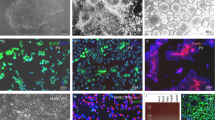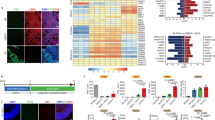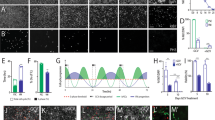Abstract
Transplantations for neurological disorders are limited by the supply of human fetal tissue. To generate larger numbers of cells of appropriate phenotype, we investigated whether human neural progenitors expanded in vitro could be modified with recombinant adenoviruses. Strong expression of β–galactosidase was obtained in vitro. Two or three weeks after transplantation of engineered cells to the rat brain, we observed a small percentage of surviving neuroblasts strongly expressing β–galactosidase in four out of 13 rats. Thus human precursor cells that have been genetically modified using adenoviruses are a promising tool for ex vivo gene therapy of neurodegenerative diseases.
This is a preview of subscription content, access via your institution
Access options
Subscribe to this journal
Receive 12 print issues and online access
$209.00 per year
only $17.42 per issue
Buy this article
- Purchase on Springer Link
- Instant access to full article PDF
Prices may be subject to local taxes which are calculated during checkout
Similar content being viewed by others
References
Lindvall, O. et al. Grafts of fetal dopamine neurons survive and improve motor function in Parkinson's disease. Science 247, 574–577 (1990).
Lindvall, O. et al Evidence for long-tern survival and function of dopaminergic grafts In progressive Parkinson's disease. Ann. Neurol. 35, 172–160 (1994).
Björklund, A. Better cells for brain repair. Nature 362, 414–415 (1993).
Groves, A.K. et al. Repair of demyelinated lesions by transplantation of purified 0-2A progenitors. Nature 362, 453–455 (1993).
Reynolds, B.A. & Weiss, S. Generation of neurons and astrocytes from isolated cells of the adult mammalian central nervous system. Science 255, 1707–1710 (1992).
Cattaneo, E. & McKay, R. Proliferation and differentiation of neuronal stem cells regulated by nerve growth factor. Nature 347, 762–765 (1990).
Ray, J., Peterson, D.A., Schinstine, M. & Gage, F.H., Proliferation, differentiation, and long term culture of primary hippocampal neurons. Proc. natn. Acad. Sci. U.S.A. 90, 3602–3606 (1993).
Renfranz, P.J., Cunningham, M.G. & McKay, R.D.G. Region-specific differentiation of the hippocampal stem cell line HIB5 upon implantation into the developing mammalian brain. Cell 66, 713–729 (1991).
Snyder, E.Y. et al. Multipotent neural cell lines can engraft and participate in development of mouse cerebellum. Cell 68, 33–51 (1992).
Luskin, M.B., Pearlman, A.L. & Sanes, J.R. Cell lineage In the cerebral cortex of the mouse studied in vivo and in vitro with a recombinant retrovirus. Neuron 1, 635–647 (1988).
Horellou, P., Lundberg, C., Robert, J.-J., Björklund, A. & Mallet, J. Gene transfer in situ and in cells for intracerebral transplantation. Semin. Neurosci. 5, 453–459 (1993).
Le Gal La Salle, G. et al. An adenovirus vector for gene transfer into neurons and glia in the brain. Science 259, 988–990 (1993).
Davidson, B.L., Allen, E.D., Kozarsky, K.F., Wilson, J.M. & Roessler, B.J. A model system for in vivo gene transfer into the central nervous system using an adenoviral vector. Nature Genet. 3, 219–223 (1993).
Akli, S. et al. Transfer of a foreign gene into the brain using adenovirus vectors. Nature Genet. 3, 224–228 (1993).
Bajocchi, G., Feldman, S.H., Crystal, R.G. & Mastrangeli, A., in vivo gene transfer to ependymal cells in the central nervous system using recombinant adenovirus vectors. Nature Genet. 3, 229–234 (1993).
Frederiksen, K. & McKay, R. Proliferation and differentiation of rat neuroepithelial precursor cells in vivo. J. Neurosci. 8, 1144–1151 (1988).
Stagaard, M. & Mollgard, K. The developing neuroepithelium in human embryonic and fetal brain studied with nestin-immunocytochemistry. Anat. Embryol. 180, 17–28 (1989).
Buc-Caron, M.H. Neuroepithelial progenitor cells explanted from human fetal brain proliferate and differentiate in vitro. Neurobiol. Dis. (In the press).
Stratford-Perricaudet, L.D., Levrero, M., Chase, J.F., Perricaudet, M. & Briand, P. Widespread long-term gene transfer to mouse skeletal muscle and heart. J. clin. Invest. 90, 626–630 (1992).
C. et al. Adenoviral vector as a gene delivery system into cultured rat neuronal and glial cells. Eur. J. Neurosci. 5, 1287–1291 (1993).
Lal, B., Cahan, M.A., Couraud, P.-O., Goldstein, G.W. & Laterra, J. Development of endogenous β-galactosidase and auto fluorescence in rat brain microvessels: implications for cell tracking and gene transfer studies. J. Histochem. Cytochem. 42, 953–956 (1994).
Shimohama, S. et al. Grafting genetically modified cells Into the rat brain: Characteristics of E. coli β-galactosidase as a reporter gene. Molec. Brain Res. 5, 271–278 (1989).
Kato, K., Suzuki, F., Watanabe, T., Semba, R. & Keino, H. Developmental profile of three enolase Isoenzymes in rat brain determination from one-cell embryo to adult brain. Neurochem. Int. 6, 51–54 (1984).
Denoulet, P., Edde, B. & Gros, F. Differential expression of several neurospecific b-tubuiin mRNAs in the mouse brain during development. Gene 50, 289–297 (1986).
Tucker, R.P. The roles of microtubule-associated proteins in brain morphogenesis: a review. Brain Res. Rev. 15, 101–120 (1990).
Tohyama, T., Lee, V.M.-Y., Rorke, L.B. & Trojanowski, J.Q. Molecular milestones that signal axonal maturation and the commitment of human spinal cord precursor cells to the neuronal or glial phenotype in development. J. comp. Neurol. 310, 285–299 (1991).
Raff, M.C. Glial cell diversification in the rat optic nerve. Science 243, 1450–1454 (1989).
Brundin, P. et al. Human fetal dopamine neurons grafted in a rat model of Parkinson's disease: immunological aspects, spontaneous and drug-induced behavior, and dopamine release. Exp. Brain Res. 70, 192–208 (1988).
Kaplitt, M.G. et al. Long-term gene expression and phenotypic correction using adeno-associated virus vectors in the mammalian brain. Nature Genet 8, 148–153 (1994).
During, M.J., Naegele, J.R., O'Malley, K.L. & Geller, A.I. Long-term behavioral recovery in parkinsonian rats by an HSV vector expressing tyrosine hydroxylase. Science 266, 1399–1403 (1994).
Horellou, P. et al. Direct intracerebral gene transfer of an adenoviral vector expressing tyrosine hydroxylase in a rat model of Parkinson's disease. Neuro Report 6, 49–63 (1994).
Fisher, L.J., Jinnah, H.A., Kale, L.C., Higgins, G.A. & Gage, F.H. Survival and function of intrastriatally grafted primary fibroblasts genetically modified to produce L-dopa. Neuron 6, 371–380 (1991).
Jiao, S., Guevich, V. & Wolff, J.A. Long-term correction of rat model of Parkinson's disease by gene therapy. Nature 362, 450–453 (1993).
Horellou, P., Brundin, P., Kalén, P., Mallet, J. & Björklund, A. In vivo release of DOPA and dopamine from genetically engineered cells grafted to the denervated rat striatum, Neuron 5, 393–402 (1990).
Levallois, C., Privat, A. & Mallet, J. Adenovirus insertion encoding the Lac Z gene in human nervous cells in primary dissociated cultures. C. r. Acad. Sci. Paris, Life Sci. 317, 495–498 (1994).
Ridoux, V. et al. The use of adenovirus vectors for intracerebral grafting of transfected nervous cells. Neuro Report 5, 801–804 (1994).
Yang, Y. et al. Inactivation of E2A in recombinant adenoviruses improves the prospect for gene therapy in cystic fibrosis. Nature Genet. 7, 362–369 (1994).
Brundin, P., issection, preparation, and implantation of human embryonic tissue, in Neural Transplantation, A Practical Approach, (eds Dunnnett, S. & Björklund, A.) 8, 139–160 (I RL Press, Oxford 1992).
Bottenstein, J.E. & Sato, G.H. Growth of a rat neuroblastoma cell line in serum-free supplemented medium. Proc. natn. Acad. Sci. U.S.A. 76, 514–517 (1979).
Abercrombie, M. Estimation of nuclear population from microtome sections. Anat Rec. 94, 239–247 (1946).
Tucker, G.C., Aoyama, H., Lipinski, M., Tursz, T. & Thiery, J.P. Identical reactivity of monoclonal antibodies HNK-1 and NC-1: conservation in vertebrates on cells derived from the neural primordium and on some leucocytes. Cell Diff. 14, 223–230 (1984).
Author information
Authors and Affiliations
Rights and permissions
About this article
Cite this article
Sabaté, O., Horellou, P., Vigne, E. et al. Transplantation to the rat brain of human neural progenitors that were genetically modified using adenoviruses. Nat Genet 9, 256–260 (1995). https://doi.org/10.1038/ng0395-256
Received:
Accepted:
Issue Date:
DOI: https://doi.org/10.1038/ng0395-256
This article is cited by
-
Human embryonic stem cell-derived neurons establish region-specific, long-range projections in the adult brain
Cellular and Molecular Life Sciences (2012)
-
Gene therapy in Parkinson?s disease
Cell and Tissue Research (2004)
-
Global gene and cell replacement strategies via stem cells
Gene Therapy (2002)
-
Transduction of human neural progenitor cells using recombinant adeno-associated viral vectors
Gene Therapy (2002)
-
Stem cell therapy and gene transfer for regeneration
Gene Therapy (2000)



